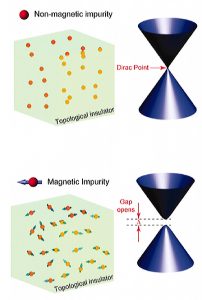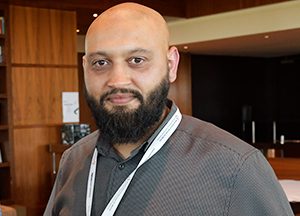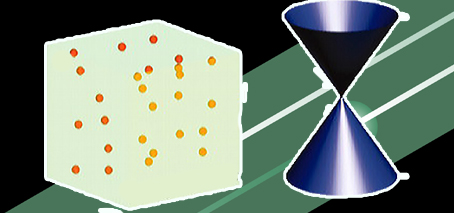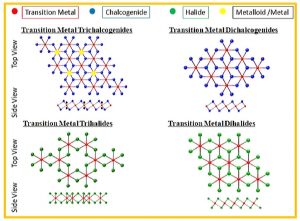* Two-dimensional magnetism reviewed in new, collaborative review
A collaborative FLEET study has reviewed recent progress in 2D ferromagnetism, and predict new, possible 2D ferromagnetic materials.
The study also introduces possible applications of atomically-thin ferromagnets in novel dissipationless electronics, spintronics, and other conventional magnetic technologies.
The scientists propose a new method of observing 2D ferromagnetism that could reveal new materials.
Led by Babar Shabbir (Monash University’s Engineering faculty) and Muhammad Nadeem (University of Wollongong), the study also drew on FLEET expertise at the Monash Faculty of Science and Tsinghua University (Beijing).
2D magnetism

Top: Topological insulator doped with TR-invariant impurities with Dirac point similar to in undoped case. Bottom: Topological insulator doped with TR-breaking impurities with broken Dirac point.
The inherent susceptibility of 2D materials to thermal fluctuations poses a major challenge to achieving ferromagnetic order in such materials.
2D ferromagnetism is interesting not just for the fundamental physics discoveries it can unlock, but as a possible ‘missing ingredient’ necessary for vdW heterostructure spintronics.
The ferromagnetism of robust, atomically-thin ferromagnets is thought to be enabled by magnetocrystalline anisotropy, which suppresses thermal fluctuations.
Recent ground-breaking discoveries of long-range, intrinsic ferromagnetism in 2D materials could start a new era in the field of spintronics and conventional magnetism technologies.
However it is very difficult to determine ferromagnetism in 2D materials, because thermal energy inevitably penetrates into a ferromagnetic material and could excites the aligned electron spins at non-zero temperatures.
However, the scientists found that magnetic anisotropy could make it possible to observe 2D ferromagnetism.

Monash postdoc Dr Babar Shabbir studies 2D materials with a focus on phonon-polaritons and ferromagnetism.
The paper:
- reviews recent progress in 2D ferromagnetism
- studies the role of magnetic anisotropy in 2D ferromagnets
- predicts new, possible 2D ferromagnets, and how to find them
- investigates the role of ferromagnetism in topological phases
- discusses possible applications of atomically-thin ferromagnets in novel dissipationless electronics, spintronics, and other conventional magnetic technologies.
The review will assist the scientific community in its exploration of novel 2D ferromagnetic families, potentially spawning new technologies and further improving the fundamental understanding of this fascinating area.
The study
Long range intrinsic ferromagnetism in two dimensional materials and dissipationless future technologies (DOI 10.1063/1.5040694) was published in Applied Physics Reviews in November 2018.
As well as funding from the Australian Research Council the researchers acknowledge the support of the Shenzhen Nanshan District Pilotage Team Program, China Postdoctoral Science Foundation, National Natural Science Foundation of China, International Postdoctoral Exchange Fellowship Program of China, and Hubei Provincial Natural Science Foundation.
Collaborators:
-
FLEET Research Fellow Dr Babar Shabbir (Monash University)
- PhD student Muhammad Nadeem (University of Wollongong)
- FLEET Research Fellow Dr Zhigao Dai (Monash University)
- FLEET Chief Investigator Prof Michael Fuhrer (Monash University)
- FLEET Partner Investigator Prof Qi-Kun Xue (Tsinghua University)
- FLEET Chief Investigator Prof Xiaolin Wang (University of Wollongong)
- FLEET Chief Investigator A/Prof Qiaoliang Bao (Monash University)
Novel materials study at FLEET
 Novel and atomically-thin materials are studied at FLEET, an Australian Research Council Centre of Excellence, within the Centre’s Enabling technology A.
Novel and atomically-thin materials are studied at FLEET, an Australian Research Council Centre of Excellence, within the Centre’s Enabling technology A.
Each of FLEET’s three research themes are heavily enabled by these novel materials, including 2D topological materials (Research Theme 1), atomically thin semiconductors (as hosts for excitons in Research Theme 2, and for realising non-equilibrium topological phenomena in Research Theme 3).
FLEET is an ARC-funded research centre bringing together over a hundred Australian and international experts to develop a new generation of ultra-low energy electronics, motivated by the need to reduce the energy consumed by computing.
More information:
- Contact Babar Shabbir babar.shabbir@monash.edu
- Connect at @FLEETCentre
- Visit FLEET.org.au
- Read FLEET Enabling technology A: atomically-thin materials news
- Contact FLEET media@FLEET.org.au
- Watch Future solutions to computation energy use
- Subscribe FLEET.org.au/news



